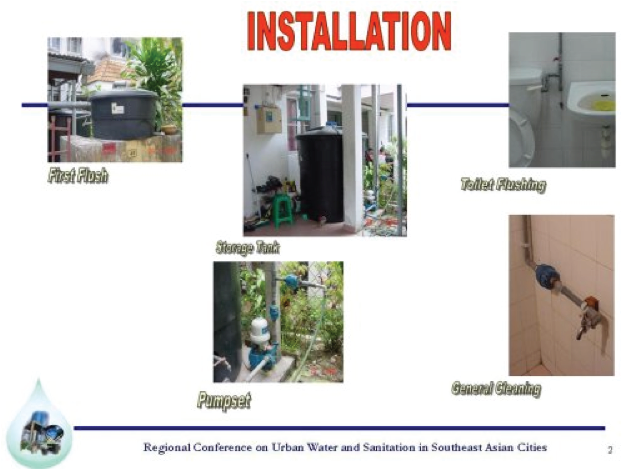Rainfall Harvesting In Malaysia
Rainfall Harvesting is a Common Practice in Many Countries
CHINA: 5 million people are served by RHS eventhough the average rainfall is 300-400mm per year.
JAPAN: rainwater is harvested for non-potable needs as well as for storgae use during droughts. A good example is in City Hall & Stadium in Sumida.
GERMANY: 50,000 RHS are installed every year (Domestic & Industry).
WHY DO RAINFALL HARVESTING?: Economic incentives & necessity are reasons why households, factories, businesses etc are willing to install RHS in places like Texas, Hawaii, Australia, Germany, Japan & other European countries. Malaysia must provide such incentives if it really wants to push for RHS.
MALAYSIA HAS HIGH RAINFALL
SUITABLE FOR RAINFALL HARVESTING (RH)
Average Rainfall = 3000 mm per year
In the past, Malaysians in rural areas harvest rainfall for daily needs
RH was acceptable & as many areas do not have piped water
Rural folks use simple & practical RH systems
For a factory in the Free Trade Zone (FTZ) in Penang, the water yield is calculated as:
Total Rainfall (Water) Yield = Roof Area X Drainage Coefficient (0.8) X Annual Rainfall
= 1000 m2 X 0.8 X 2505 mm per year
= 1000 m2 X 0.8 X 2.505 m
= 2004.0 m3
= 2,004,000 litres per year
Based on normal usage of a 500 workers:
= 500 persons X 100 litres (Only Flushing toilet)
= 50,000 litres per day
= 18,250,000 litres per year
The rainfall harvested can fulfill about 11.0 % of total water needs of this factory. In monetary terms, based on the average rate of 78 sen per 1,000 litres (or 0.078 sen/litre), the factory will save RM156,312.00 (US$42,246.49) per year.
SAVINGS FROM USING RAINWATER
B Block, Department of Irrigation &Drainage, Jalan Ampang
ITEM JBA WATER SUPPLY SAVINGS USING RHS
Monthly Usage (Based on water Bill) 260 m3 180 m3
Monthly water Bill (80 sen/m3) RM 208.10 RM 144.00
Annual Water Bill RM 2,497.20 RM 1,728.00
Savings 70 %
Table 2: Water Quality of Rainwater (Source: NAHRIM, in Rozman Mohamad, 2006)
Parameter in Polyvinyl Tanks Unit Rainwater Harvested WHO Drinking Water Std
Ph mg/l 6.0 6.5-6.8
Sulphate mg/l 0 250
Chloride mg/l <0.3 250
Iron mg/l 0.2 0.3
Nitrate mg/l 0.5 50
Coliform Count/100mL 1-27 0
* NOTE: Although Rainwater Quality is found to be of acceptable standard, it is untreated and should not be used for consumption. Rainwater should only be used for washing cars, floors, toilets, flushing, watering plants and other non-consumptive usage (Source: Hj Ahamd et. al., 1999 Alternative Water Supply Options: Rainfall Harvesting. In “Sustainable Management of water Resources in Malaysia” Published by Global Environment Centre, 1999).
DRINKING IS ONLY ADVISABLE IF TREATED BY FILTRATION & DISINFECTION SYSTEM CERTIFIED BY THE AUTHORITIES
COMPONENTS OF A ROOFTOP RAINFALL HARVESTING SYSTEM
(a) Roof (b) Gutter (c) Piping System to collect rainwater from gutter to channel into tank (d) Filter (can be a simple wiremesh system to filter leaves and dirt) (e) Water Tank (can above or underground. Tanks should be cleaned at least once a month. To prevent mosquito breeding, put into tank Ubat Jentik) (f) Water Pump (if water is needed to be pumped unstairs or if tank is underground. It is better to put the tank just below roof and use gravity flow to channel rainwater into cistern and tap for use).
CURRENT EXAMPLES OF RAINFALL HARVESTING IN MALAYSIA
GOVERNMENT BUILDINGS:
Drainage & Irrigation Department Malaysia Headquarters
-Another 5 locations have been identified for installation of RHS in 2006 (including Tioman Island, a tourist resort)
INDUSTRY:
Flextronics Factory (Previously Ericsson) in Shah Alam
PUBLIC BUILDINGS:
Bukit Indah Mosque, Ampang
HOUSING PROJECT:
Section 9 Kota Damansara, Petaling Jaya (PKNS Project)
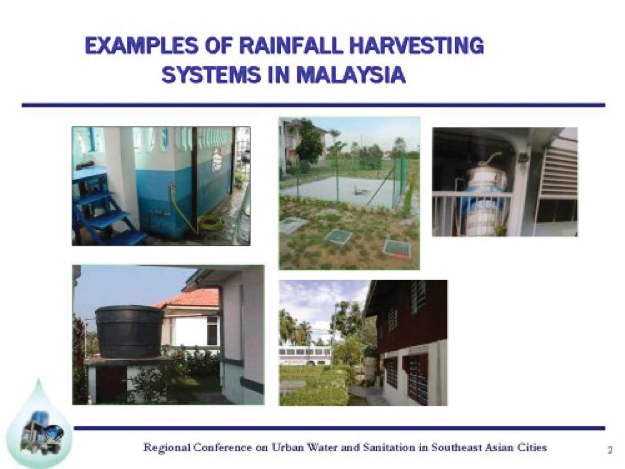
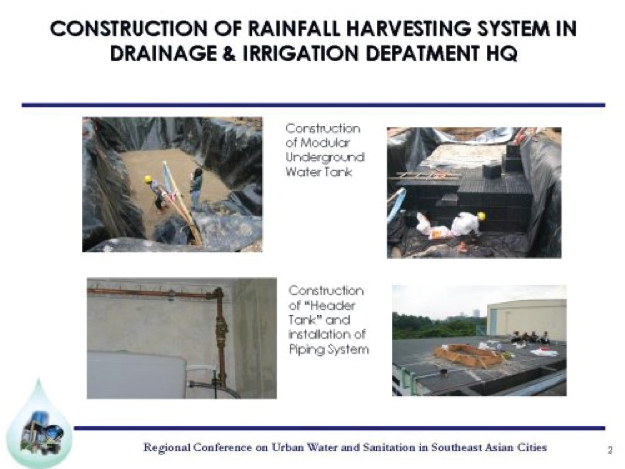
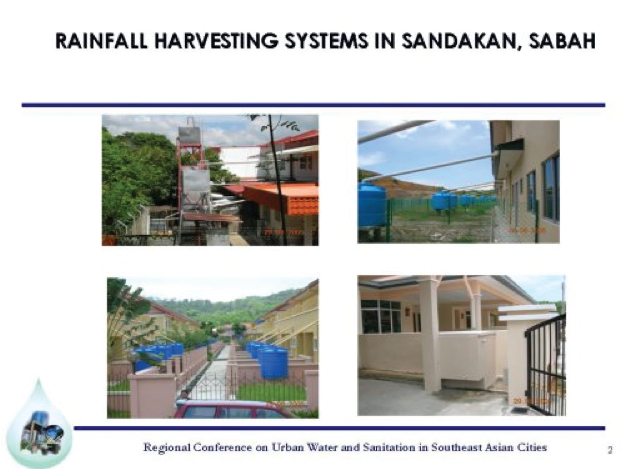
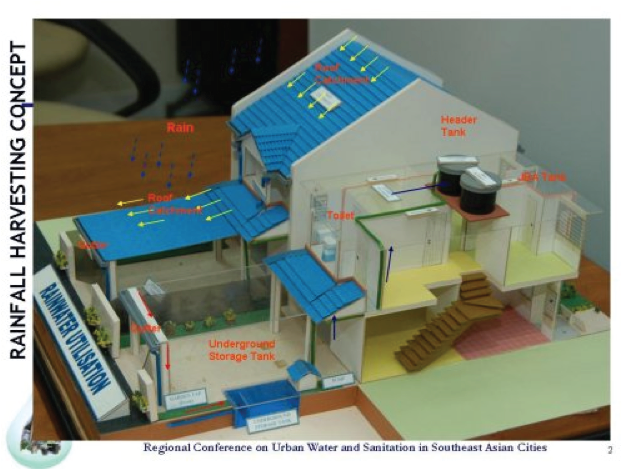
Source: Rozman Mohamad (2006) “Penjimatan Air Menerusi Penggunaan Sumber Air Terabai – Air Hujan”. Paper presented at the National Seminar by Ministry of Energy, Water and Communications (KTAK) and Federation of Malaysian Consumers Association (FOMCA) “National Water Awareness and Saving Campaign”, 31 July 2006, Kuala Lumpur.
FOR THOSE WHO ARE INTERESTED IN INSTALLING A RAINFALL HARVESTING UNIT IN YOUR HOME, PLEASE CONTACT THE FOLLOWING EXPERTS IN RAINFALL HARVESTING:
(1) Ir Tuan Haji Ahmad Jamaludin Shaaban of National Hydraulic Research Institute Malaysia (NAHRIM), Block A, JPS Malaysia, Cawangan Ampang, 60000 Kuala Lumpur
(2) Rozman Mohamad of JPS Malaysia, Cawangan Ampang, 60000 Kuala Lumpur.
LINKS TO RAINFALL HARVESTING SITES:



